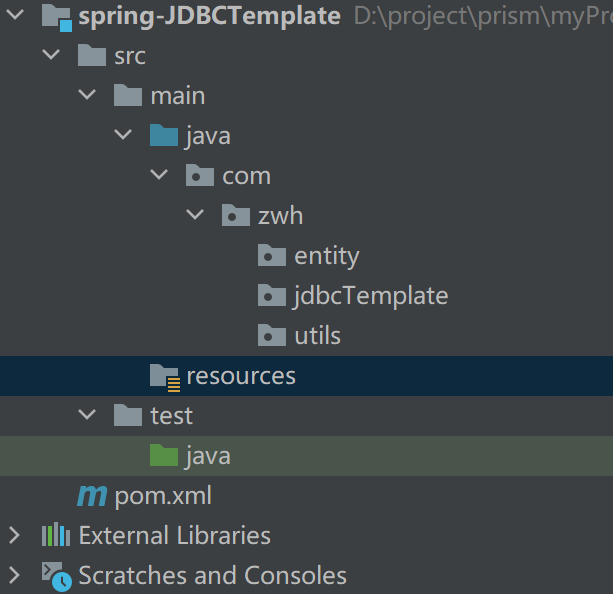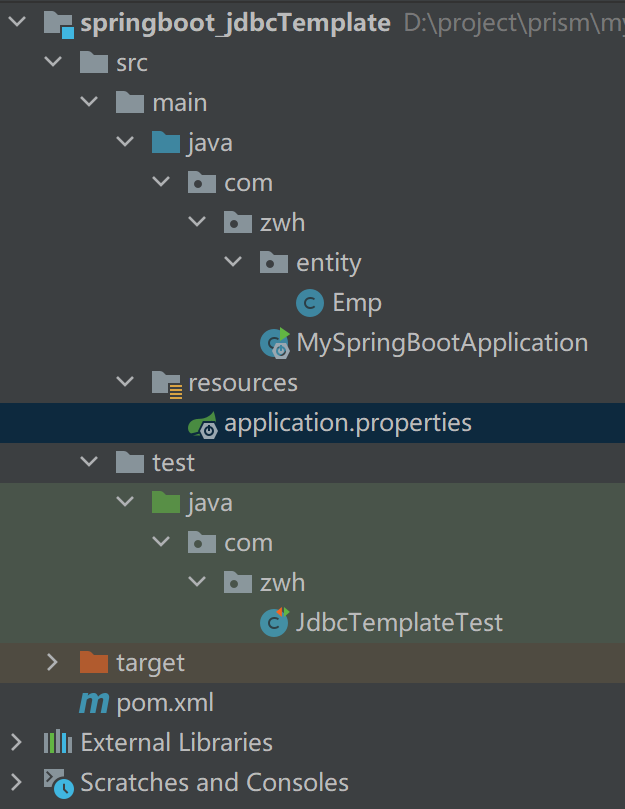一、spring JDBC
Spring框架对JDBC的简单封装。提供了一个JDBCTemplate对象简化JDBC的开发。
步骤:
1、 添加依赖
2、创建JdbcTemplate对象。依赖于数据源DataSource
* JdbcTemplate template = new JdbcTemplate(ds);
3、调用JdbcTemplate的方法来完成CRUD的操作
* update():执行DML语句。增、删、改语句。
* queryForMap():查询结果将结果集封装为map集合,将列名作为key,将值作为value 将这条记录封装为一个map集合。
注意:这个方法查询的结果集长度只能是1
* queryForList():查询结果将结果集封装为list集合。
注意:将每一条记录封装为一个Map集合,再将Map集合装载到List集合中
* query():查询结果,将结果封装为JavaBean对象。
query的参数:RowMapper
一般我们使用BeanPropertyRowMapper实现类。可以完成数据到JavaBean的自动封装
new BeanPropertyRowMapper<类型>(类型.class)
* queryForObject:查询结果,将结果封装为对象。
一般用于聚合函数的查询
二、Spring的JDBCTemplate入门
* 需求:
1)、修改1号数据的 salary 为 10000
2)、添加一条记录
3)、删除刚才添加的记录
4)、查询id为1的记录,将其封装为Map集合
5)、查询所有记录,将其封装为List
6)、查询所有记录,将其封装为Emp对象的List集合
7)、查询总记录数
1、创建maven的Java工程
补齐目录后如下所示

2、添加依赖
<dependencies>
<dependency>
<groupId>org.springframework</groupId>
<artifactId>spring-jdbc</artifactId>
<version>4.2.5.RELEASE</version>
</dependency>
<dependency>
<groupId>org.springframework</groupId>
<artifactId>spring-tx</artifactId>
<version>4.2.5.RELEASE</version>
</dependency>
<dependency>
<groupId>org.springframework</groupId>
<artifactId>spring-core</artifactId>
<version>4.2.5.RELEASE</version>
</dependency>
<dependency>
<groupId>org.springframework</groupId>
<artifactId>spring-beans</artifactId>
<version>4.2.5.RELEASE</version>
</dependency>
<!-- 连接到mysql -->
<dependency>
<groupId>mysql</groupId>
<artifactId>mysql-connector-java</artifactId>
<version>8.0.22</version>
</dependency>
<dependency>
<groupId>com.alibaba</groupId>
<artifactId>druid</artifactId>
<version>1.2.1</version>
</dependency>
<dependency>
<groupId>org.projectlombok</groupId>
<artifactId>lombok</artifactId>
<version>1.18.8</version>
</dependency>
</dependencies>
3、在resources目录下新建druid.properties文件
driverClassName=com.mysql.cj.jdbc.Driver url=jdbc:mysql://localhost:3306/jdbcTemplate?useSSL=false&serverTimezone=UTC username=root password=123456 initialSize=5 maxActive=10 maxWait=3000
4、创建emp表
CREATE TABLE `emp` ( `id` int(0) NOT NULL AUTO_INCREMENT, `ename` varchar(20) CHARACTER SET utf8 COLLATE utf8_general_ci NULL DEFAULT NULL, `job_id` int(0) NULL DEFAULT NULL, `mgr` int(0) NULL DEFAULT NULL, `joindate` datetime(0) NULL DEFAULT NULL, `salary` double(10, 2) NULL DEFAULT NULL, `bonus` double(10, 2) NULL DEFAULT NULL, `dept_id` int(0) NULL DEFAULT NULL, PRIMARY KEY (`id`) USING BTREE ) ENGINE = InnoDB CHARACTER SET = utf8 COLLATE = utf8_general_ci ROW_FORMAT = Dynamic;
5、添加Druid连接池的工具类来获取连接
import com.alibaba.druid.pool.DruidDataSourceFactory; import javax.sql.DataSource; import java.io.IOException; import java.sql.Connection; import java.sql.ResultSet; import java.sql.SQLException; import java.sql.Statement; import java.util.Properties; /** * Druid连接池的工具类 */ public class JDBCUtils { //1.定义成员变量 DataSource private static DataSource ds ; static{ try { //1.加载配置文件 Properties pro = new Properties(); pro.load(JDBCUtils.class.getClassLoader().getResourceAsStream("druid.properties")); //2.获取DataSource ds = DruidDataSourceFactory.createDataSource(pro); } catch (IOException e) { e.printStackTrace(); } catch (Exception e) { e.printStackTrace(); } } /** * 获取连接 */ public static Connection getConnection() throws SQLException { return ds.getConnection(); } /** * 释放资源 */ public static void close(Statement stmt,Connection conn){ /* if(stmt != null){ try { stmt.close(); } catch (SQLException e) { e.printStackTrace(); } } if(conn != null){ try { conn.close();//归还连接 } catch (SQLException e) { e.printStackTrace(); } }*/ close(null,stmt,conn); } public static void close(ResultSet rs , Statement stmt, Connection conn){ if(rs != null){ try { rs.close(); } catch (SQLException e) { e.printStackTrace(); } } if(stmt != null){ try { stmt.close(); } catch (SQLException e) { e.printStackTrace(); } } if(conn != null){ try { conn.close();//归还连接 } catch (SQLException e) { e.printStackTrace(); } } } /** * 获取连接池方法 */ public static DataSource getDataSource(){ return ds; } }
测试能否获取连接
public class DruidDemo { public static void main(String[] args) throws Exception { //1.导入jar包 //2.定义配置文件 //3.加载配置文件 Properties pro = new Properties(); InputStream is = DruidDemo.class.getClassLoader().getResourceAsStream("druid.properties"); pro.load(is); //4.获取连接池对象 DataSource ds = DruidDataSourceFactory.createDataSource(pro); //5.获取连接 Connection conn = ds.getConnection(); System.out.println(conn); } }
结果如下:
com.mysql.cj.jdbc.ConnectionImpl@77caeb3e
6、创建实体类
@Data @Accessors(chain = true) public class Emp { private Integer id; private String ename; private Integer job_id; private Integer mgr; private Date joindate; private Double salary; private Double bonus; private Integer dept_id; }
7、新建测试类进行测试
1)、添加
public class JdbcTemplateDemo2 { //1. 获取JDBCTemplate对象 private JdbcTemplate template = new JdbcTemplate(JDBCUtils.getDataSource()); /** * 1. 添加一条记录 */ @Test public void test2(){ String sql = "insert into emp(id,ename,dept_id) values(?,?,?)"; int count = template.update(sql, 1015, "郭靖", 10); System.out.println(count); } }
结果如下:

2)、修改
public class JdbcTemplateDemo2 { //1. 获取JDBCTemplate对象 private JdbcTemplate template = new JdbcTemplate(JDBCUtils.getDataSource()); /** * 1. 修改1015号数据的 salary 为 10000 */ @Test public void test1(){ //2. 定义sql String sql = "update emp set salary = 10000 where id = 1015"; //3. 执行sql int count = template.update(sql); System.out.println(count); } }
结果如下:

3)、删除
public class JdbcTemplateDemo2 { //1. 获取JDBCTemplate对象 private JdbcTemplate template = new JdbcTemplate(JDBCUtils.getDataSource());/** * 3.删除刚才添加的记录 */ @Test public void test3(){ String sql = "delete from emp where id = ?"; int count = template.update(sql, 1015); System.out.println(count); } }
4)、查询
public class JdbcTemplateDemo2 { //1. 获取JDBCTemplate对象 private JdbcTemplate template = new JdbcTemplate(JDBCUtils.getDataSource()); /** * 4.查询id为1001的记录,将其封装为Map集合 * 注意:这个方法查询的结果集长度只能是1 */ @Test public void test4(){ String sql = "select * from emp where id = ?"; Map<String, Object> map = template.queryForMap(sql, 1001); System.out.println(map); //{id=1001, ename=孙悟空, job_id=4, mgr=1004, joindate=2000-12-17, salary=10000.00, bonus=null, dept_id=20} } }
结果如下:
{id=1001, ename=孙悟空, job_id=4, mgr=1004, joindate=2021-12-17 08:00:00.0, salary=10000.0, bonus=null, dept_id=20}
5)、查询所有记录,将其封装成List
public class JdbcTemplateDemo2 { //1. 获取JDBCTemplate对象 private JdbcTemplate template = new JdbcTemplate(JDBCUtils.getDataSource()); /** * 5. 查询所有记录,将其封装为List */ @Test public void test5(){ String sql = "select * from emp"; List<Map<String, Object>> list = template.queryForList(sql); for (Map<String, Object> stringObjectMap : list) { System.out.println(stringObjectMap); } } }
结果:
{id=1001, ename=孙悟空, job_id=4, mgr=1004, joindate=2021-12-17 08:00:00.0, salary=10000.0, bonus=null, dept_id=20}
{id=1015, ename=郭靖, job_id=null, mgr=null, joindate=null, salary=10000.0, bonus=null, dept_id=10}
6)、查询所有记录,将其封装为Emp对象的List集合
public class JdbcTemplateDemo2 { //1. 获取JDBCTemplate对象 private JdbcTemplate template = new JdbcTemplate(JDBCUtils.getDataSource()); /** * 6. 查询所有记录,将其封装为Emp对象的List集合 */ @Test public void test6(){ String sql = "select * from emp"; List<Emp> list = template.query(sql, new RowMapper<Emp>() { @Override public Emp mapRow(ResultSet rs, int i) throws SQLException { Emp emp = new Emp(); int id = rs.getInt("id"); String ename = rs.getString("ename"); int job_id = rs.getInt("job_id"); int mgr = rs.getInt("mgr"); Date joindate = rs.getDate("joindate"); double salary = rs.getDouble("salary"); double bonus = rs.getDouble("bonus"); int dept_id = rs.getInt("dept_id"); emp.setId(id); emp.setEname(ename); emp.setJob_id(job_id); emp.setMgr(mgr); emp.setJoindate(joindate); emp.setSalary(salary); emp.setBonus(bonus); emp.setDept_id(dept_id); return emp; } }); for (Emp emp : list) { System.out.println(emp); } } }
结果如下:
Emp(id=1001, ename=孙悟空, job_id=4, mgr=1004, joindate=2021-12-17, salary=10000.0, bonus=0.0, dept_id=20) Emp(id=1015, ename=郭靖, job_id=0, mgr=0, joindate=null, salary=10000.0, bonus=0.0, dept_id=10)
一般我们使用BeanPropertyRowMapper实现类。可以完成数据到JavaBean的自动封装
public class JdbcTemplateDemo2 { //1. 获取JDBCTemplate对象 private JdbcTemplate template = new JdbcTemplate(JDBCUtils.getDataSource()); @Test public void test6_2(){ String sql = "select * from emp"; List<Emp> list = template.query(sql, new BeanPropertyRowMapper<Emp>(Emp.class)); for (Emp emp : list) { System.out.println(emp); } } }
三、SpringBoot整合JDBCTemplate
1、创建一个maven的java工程

2、添加依赖
<parent>
<groupId>org.springframework.boot</groupId>
<artifactId>spring-boot-starter-parent</artifactId>
<version>2.1.0.RELEASE</version>
</parent>
<properties>
<maven.compiler.source>8</maven.compiler.source>
<maven.compiler.target>8</maven.compiler.target>
</properties>
<dependencies>
<dependency>
<groupId>org.springframework.boot</groupId>
<artifactId>spring-boot-starter-jdbc</artifactId>
</dependency>
<dependency>
<groupId>mysql</groupId>
<artifactId>mysql-connector-java</artifactId>
<scope>runtime</scope>
</dependency>
<dependency>
<groupId>org.projectlombok</groupId>
<artifactId>lombok</artifactId>
<version>1.18.8</version>
</dependency>
<!--测试的起步依赖-->
<dependency>
<groupId>org.springframework.boot</groupId>
<artifactId>spring-boot-starter-test</artifactId>
<scope>test</scope>
</dependency>
</dependencies>
3、在resources目录下添加application.properties
spring.datasource.url=jdbc:mysql://localhost:3306/jdbcTemplate?useSSL=false&serverTimezone=UTC spring.datasource.username=root spring.datasource.password=123456 spring.datasource.driver-class-name=com.mysql.cj.jdbc.Driver
4、创建emp表
CREATE TABLE `emp` ( `id` int(0) NOT NULL AUTO_INCREMENT, `ename` varchar(20) CHARACTER SET utf8 COLLATE utf8_general_ci NULL DEFAULT NULL, `job_id` int(0) NULL DEFAULT NULL, `mgr` int(0) NULL DEFAULT NULL, `joindate` datetime(0) NULL DEFAULT NULL, `salary` double(10, 2) NULL DEFAULT NULL, `bonus` double(10, 2) NULL DEFAULT NULL, `dept_id` int(0) NULL DEFAULT NULL, PRIMARY KEY (`id`) USING BTREE ) ENGINE = InnoDB CHARACTER SET = utf8 COLLATE = utf8_general_ci ROW_FORMAT = Dynamic;
5、创建Emp类
@Data @Accessors(chain = true) public class Emp { private Integer id; private String ename; private Integer job_id; private Integer mgr; private Date joindate; private Double salary; private Double bonus; private Integer dept_id; }
6、创建启动类
@SpringBootApplication public class MySpringBootApplication { public static void main(String[] args) { SpringApplication.run(MySpringBootApplication.class); } }
7、创建启动类进行测试
注意:JdbcTemplate直接注入即可
@RunWith(SpringRunner.class) @SpringBootTest(classes = MySpringBootApplication.class) public class JdbcTemplateTest { @Resource private JdbcTemplate template; /** * 1. 添加一条记录 */ @Test public void test2(){ String sql = "insert into emp(id,ename,dept_id) values(?,?,?)"; int count = template.update(sql, 1015, "郭靖", 10); System.out.println(count); } /** * 1. 修改1015号数据的 salary 为 10000 */ @Test public void test1(){ //2. 定义sql String sql = "update emp set salary = 10000 where id = 1015"; //3. 执行sql int count = template.update(sql); System.out.println(count); } /** * 3.删除刚才添加的记录 */ @Test public void test3(){ String sql = "delete from emp where id = ?"; int count = template.update(sql, 1015); System.out.println(count); } /** * 4.查询id为1001的记录,将其封装为Map集合 * 注意:这个方法查询的结果集长度只能是1 */ @Test public void test4(){ String sql = "select * from emp where id = ?"; Map<String, Object> map = template.queryForMap(sql, 1001); System.out.println(map); //{id=1001, ename=孙悟空, job_id=4, mgr=1004, joindate=2000-12-17, salary=10000.00, bonus=null, dept_id=20} } /** * 5. 查询所有记录,将其封装为List */ @Test public void test5(){ String sql = "select * from emp"; List<Map<String, Object>> list = template.queryForList(sql); for (Map<String, Object> stringObjectMap : list) { System.out.println(stringObjectMap); } } /** * 6. 查询所有记录,将其封装为Emp对象的List集合 */ @Test public void test6(){ String sql = "select * from emp"; List<Emp> list = template.query(sql, new RowMapper<Emp>() { @Override public Emp mapRow(ResultSet rs, int i) throws SQLException { Emp emp = new Emp(); int id = rs.getInt("id"); String ename = rs.getString("ename"); int job_id = rs.getInt("job_id"); int mgr = rs.getInt("mgr"); Date joindate = rs.getDate("joindate"); double salary = rs.getDouble("salary"); double bonus = rs.getDouble("bonus"); int dept_id = rs.getInt("dept_id"); emp.setId(id); emp.setEname(ename); emp.setJob_id(job_id); emp.setMgr(mgr); emp.setJoindate(joindate); emp.setSalary(salary); emp.setBonus(bonus); emp.setDept_id(dept_id); return emp; } }); for (Emp emp : list) { System.out.println(emp); } } @Test public void test6_2(){ String sql = "select * from emp"; List<Emp> list = template.query(sql, new BeanPropertyRowMapper<Emp>(Emp.class)); for (Emp emp : list) { System.out.println(emp); } } }
最后项目的目录如下:

我们只需要在pom.xml中加入数据库依赖,再到application.properties中配置连接信息,不需要像Spring应用中创建JdbcTemplate的Bean,就可以直接注入使用。
在test里做的测试,test包结构要保持与项目包结构一致,springboot才能自动扫描到包。